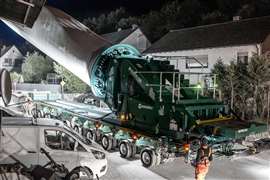Returning from injury
01 May 2008
Workplace injuries are of concern to SC&RA members and insurance professionals alike. It has been my experience over the last ten years that crane, rigging, heavy haul trucking and product manufacturing members of the association have worked hard to develop injury prevention programs by hosting regular loss control meetings with weekly toolbox talks, creating safety committees and equipment inspection formats, safety incentive programs, etc. However, after all these proactive measures, injuries still happen–and then what?
Despite members’ best efforts workplace injuries occur. It is the high risk nature of the industry that will always create an environment prone to serious work related injuries. Workplace injuries not only cost members money through workers compensation increases and lost productivity, but also can negatively affect employee morale.
What is a member company to dof Fortunately for SC&RA members who deploy best practices in risk management, a clearly defined Post Injury Management Program can improve control of injuries, and more importantly can bring the injured employee back to work with improved employee engagement and morale.
Maintaining contact
Simply put, a Post Injury Management Program is a system for monitoring workplace injuries, maintaining contact with the injured employee, and then returning the employee to modified duty as soon as possible.
Many SC&RA members have tried, or are using some type of early return to work program. A specific Post Injury Management Program goes a step further, giving the member company more control of the return to work process and also allowing them to stay connected to the injured employee. The principal shortcoming of traditional early return to work programs has been a lack of communication between employer and employee.
According to Tim Conlon, vice president, claims and risk management at SRS, “All too often, the injured employee receives only the occasional contact by a human resources department clerk or company secretary. Many injured employees at this stage feel ‘banished’ by their employer, and receive no contact from co–workers or supervisors. Typically this results in the injured employee feeling disgruntled, and all too often, these injuries result in litigious actions.”
Diary dates
The first component of a successful Post Injury Management Program is to establish a regular diary for communication. Managers, supervisors and co–workers are encouraged to contact the injured employee, letting them know they are missed and valued. Under conventional programs, managers, supervisors and co–workers have had little or no role in the process. Th is lack of communication can be destructive to employee morale and leaves the injured employee feeling disengaged. Conlon adds, “It is amazing how regular communication by the employer and coworkers can keep the spirits of an injured employee up when they are stuck at home nursing an injury and wondering how they will be able to pay their bills.”
Improved communication is fundamental to the success of a Post Injury Management Program, and this subtle change can pay huge dividends for the company and the employee.
Return to work
The second key component of the Post Injury Management Program begins when the employee returns to work. The goal is to return the employee to the workplace as soon as possible, and create “bridge jobs”.
Conlon adds, “Even in specialized (and union) work environments like crane–rigging and heavy haul trucking companies, when safety committees recognize the value of creating miscellaneous job function lists to create bridge jobs for the early return to work program participants, everyone wins and often times it keeps the lawyers out of the picture.” A bridge job is modified duty based on the employee's capabilities, and duty that bridges the gap between the employee's capabilities and their pre–injury duties.
SC&RA member companies with safety committees comprising managers, supervisors and field staff, typically can create an ongoing list of miscellaneous projects to be used for bridge jobs.
Communication with managers
The third critical component of a successful program includes communication with front line managers and supervisors. When the injured employee returns to work, front line managers and supervisors should meet human resource directors or a safety manager and determine the employee's capabilities. All discussions of the capabilities should be positive, focusing on what the employee can do, rather than focusing strictly on limitations. For example, focus on the ability to lift up to 25 pounds, rather than the limitations of not lifting anything over 25 pounds. Th is subtle shift in language has a significant impact on the morale of the injured employee, and by promoting the ability of the employee to function in the bridge job list, the employee feels supported and valued.
Tracking bridge jobs
Once these bridge jobs are established by a safety committee and selected for the injured employee, it is critical they are tracked by supervisors, and that the employee and management staf communicate (weekly) on progress. Bridge jobs are designed to be temporary, with the goal of returning the employee to their pre–injury responsibilities as soon as possible. Again, communication is key.
The Post Injury Management Program is a natural evolution of the early return to work programs that many members already have. By adopting these subtle changes SC&RA members have a great opportunity to make the injured employee feel needed.
Everyone wants to feel like a valuable part of their organization. A Post Injury Management Program provides a rare opportunity to make an injured team member feel valuable and needed. Reaching out at this critical juncture is easy to do, and can pay dividends for years to come.
STAY CONNECTED


Receive the information you need when you need it through our world-leading magazines, newsletters and daily briefings.
CONNECT WITH THE TEAM










